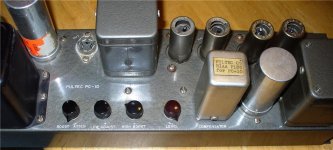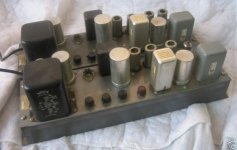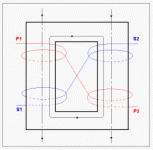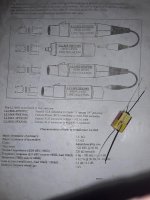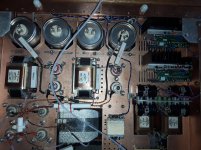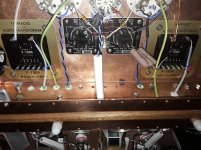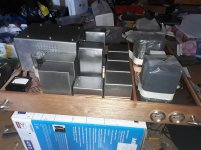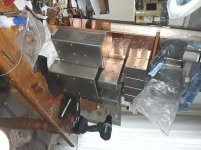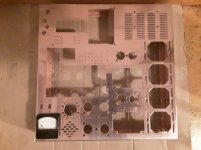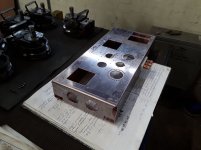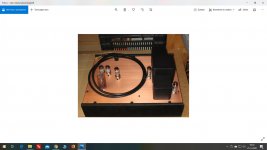separating the HT and LT raw supplies. Is this necessary for quiet operation?
I use my 26 preamp with separated power supply box (also about 1m distance) and R.C, and SSHV2 in the preamp box.
Each LT has unique PS transformer, HV so.
At the filament bias resistor I measured about 25uV noise (grounded input), so no necessity another separation.
.. separating the HT and LT raw supplies. Is this necessary for quiet operation?
In addition/support of what euro21 says: Reduce interaction of EMF between all mains powered transformers, and any associated inductors, with correct physical orientation. If you can locate them remotely from the signal chassis, great, but ensure the final signal carrying shunt element is at the signal chassis.
If you use a tube rectifier, use a seperate heater/filament transformer for the rectifier.
Ideally, all transformers would have flux bands/electrostatic shields and the installation would have a dedicated mains earth electrode to take advantage of this.
HK
Last edited:
Hello,
Especially a choke input can have a negative influence in the components in its surroundings. So after trying a big number of them i came to the conclusion that Lundahl chokes wired in common mode ( see their PDF) are the way to go!!
Try to connect your diodes or tube rectifier as closely as possible to the transformer and keep the wires to the choke twisted.
Take a look at the mono famous pc10. They are small.
You can see all the iron:
A power transformer.
an input transformer for cartridge
an output transformer
a LCR Riaa correction unit containing two coils.
The original ones no hum! I made the chassis for a group of people in France. They used a local supplier to make an EI transformer with static shield. Never heard it but the owners said only quiet if the power transformer is at distance from the chassis.
The input transformer used a special trick that can be seen in the attachment. Nobody could get hold of that one. The way it is constructed the noise will be out of fase and the signal would be in fase and it has a very good screening. So not having the original input transformer in combination with a so so power transformer and you will have some trouble to resolve.
The Pc10 manufacturer states it uses some patents from Western electric company.
So with our diy stuff we could try to get close. Rod Coleman teaches us to go for split bobbin transformer for his units. Dave Slagle developped a two coil choke ( like the Lundahls) to be used as a choke input for the Rod Coleman units so i started with the two coils chokes 10/15 years ago after the more expensive Tango ones. And recently i switched to split bobbin as well. ( smaller transformers and bigger chokes like the late Allen Wright would tell us to do)
A few years ago i also stared to use the Lundahl LL1662 to create symmetrical power supply. I started with one for my digital gear with can put a lot of garbage back into the supply from the wall. And recently i added number 4.
Because my line preamp has a symmetrical output with Tango transformer ( i needed the low output impedance) i had to use the LL1665 as a way to change the symmetrical output into a normal one once it arrives at the input tube of the power amp. I have been using these for twnty years or more. They are really good and they are small.
Greetings, Eduard
Especially a choke input can have a negative influence in the components in its surroundings. So after trying a big number of them i came to the conclusion that Lundahl chokes wired in common mode ( see their PDF) are the way to go!!
Try to connect your diodes or tube rectifier as closely as possible to the transformer and keep the wires to the choke twisted.
Take a look at the mono famous pc10. They are small.
You can see all the iron:
A power transformer.
an input transformer for cartridge
an output transformer
a LCR Riaa correction unit containing two coils.
The original ones no hum! I made the chassis for a group of people in France. They used a local supplier to make an EI transformer with static shield. Never heard it but the owners said only quiet if the power transformer is at distance from the chassis.
The input transformer used a special trick that can be seen in the attachment. Nobody could get hold of that one. The way it is constructed the noise will be out of fase and the signal would be in fase and it has a very good screening. So not having the original input transformer in combination with a so so power transformer and you will have some trouble to resolve.
The Pc10 manufacturer states it uses some patents from Western electric company.
So with our diy stuff we could try to get close. Rod Coleman teaches us to go for split bobbin transformer for his units. Dave Slagle developped a two coil choke ( like the Lundahls) to be used as a choke input for the Rod Coleman units so i started with the two coils chokes 10/15 years ago after the more expensive Tango ones. And recently i switched to split bobbin as well. ( smaller transformers and bigger chokes like the late Allen Wright would tell us to do)
A few years ago i also stared to use the Lundahl LL1662 to create symmetrical power supply. I started with one for my digital gear with can put a lot of garbage back into the supply from the wall. And recently i added number 4.
Because my line preamp has a symmetrical output with Tango transformer ( i needed the low output impedance) i had to use the LL1665 as a way to change the symmetrical output into a normal one once it arrives at the input tube of the power amp. I have been using these for twnty years or more. They are really good and they are small.
Greetings, Eduard
Attachments
Silly question Gents, though I've read the details on the preamp build, is it really a must to place the ps that far away from the 26/01a ???Cheers
No, it is not.
However, if you use an open frame choke like the Lundahl, expect complications which might otherwise have been avoided with enclosed units like the Japanese ISO, or MM from Belgium.
And as part of a lazy stroll through the garden on a late Sunday, one might be forgiven for pondering the implications of resonance frequencies, self resonance. How, when, where, why and .. what now.
HK
Last edited:
Hello Hanze,
I have used the Tango 20 Henry 150 mA designed for choke input. I bought 8 of them in Japan 20 years ago. Then already had the plan to make a direct coupled Vt25A amp which needed a voltage to close or even higher than the the Tango could take so i ordered a pair of Lundahl. Because lack of energy i didnt start the vt25a ( now almost done lol) so i made a small piece of metal so i could exchange the Tango in my power amp with the Lundahl having about thev same Henry and DCR and what i didnt expect. The Lundahl was clearly better and even got better when i changed into the same one with a smaller airgap so more Henry and less current.
If something is better i am willing to pay. The Lundahl is cheaper and when selling the Tango here at swap meet i could get more Lundahl for the money.
Never had any problem with the Lundahl being open frame! A normal qualty EI core choke covered by a nice box will still be beaten by a Lundahl. My job is '' metal business '' so very easy for me to construct a thick wall box.
The only Tango choke i am still using is now used as a second choke in a LCLC supply followed by an Allen Wright shunt regulator. The first is Lundahl as you could have guessed. Being used as input choke the differences between chokes are very easy to hear. Half a minute is enough.
greetings, Eduard
P.s As you can see in the attachment the Lundahl chokes ( 5, 2 for Rod Coleman circuits and 3 for high voltage supply) are in good company of permalloy Tango anode choke and permalloy Tamura output transformer. I have the Tango in stock but i use Lundahl
I have used the Tango 20 Henry 150 mA designed for choke input. I bought 8 of them in Japan 20 years ago. Then already had the plan to make a direct coupled Vt25A amp which needed a voltage to close or even higher than the the Tango could take so i ordered a pair of Lundahl. Because lack of energy i didnt start the vt25a ( now almost done lol) so i made a small piece of metal so i could exchange the Tango in my power amp with the Lundahl having about thev same Henry and DCR and what i didnt expect. The Lundahl was clearly better and even got better when i changed into the same one with a smaller airgap so more Henry and less current.
If something is better i am willing to pay. The Lundahl is cheaper and when selling the Tango here at swap meet i could get more Lundahl for the money.
Never had any problem with the Lundahl being open frame! A normal qualty EI core choke covered by a nice box will still be beaten by a Lundahl. My job is '' metal business '' so very easy for me to construct a thick wall box.
The only Tango choke i am still using is now used as a second choke in a LCLC supply followed by an Allen Wright shunt regulator. The first is Lundahl as you could have guessed. Being used as input choke the differences between chokes are very easy to hear. Half a minute is enough.
greetings, Eduard
P.s As you can see in the attachment the Lundahl chokes ( 5, 2 for Rod Coleman circuits and 3 for high voltage supply) are in good company of permalloy Tango anode choke and permalloy Tamura output transformer. I have the Tango in stock but i use Lundahl
Attachments
Hello Hanze,
I have used the Tango 20 Henry 150 mA designed for choke input. The Lundahl is cheaper and when selling the Tango here at swap meet i could get more Lundahl for the money.
Hello eduard,
I use hammond choke input filters, your LL in CM mode would be a welcome technical improvement to me
Sorry for not being clearer, my comments were in regard to high inductance open frame plate load chokes to suit ~10k Rp types, on a single chassis sharing power supply and signal.
Nice OPT !! I see F7003 on eBay at the moment (not affiliated). Nice chassis too, can we see photograph of the top side?.
HK
Last edited:
Hello,
For ME the best way to use the Lundahl is in common mode and in choke input so both combined.
An easy way to find out how to position a choke is connecting it to an ac meter and not to the circuit itself and see which position gives the lowest reading. The higher the Henry the higher the reading will be. For this purpose i use a LL1668 ? 100 H 25 mA .
With the Lundahl you will see there is not so much difference between the you mount them. I also have 100H chokes in a plastic enclosure filled with a resin very probably an EI core there the differences are HUGE.
Using the RIGHT input choke also will make your power transformer and the associated wires with ac voltage give less radiation .
Greetings, Eduard
For ME the best way to use the Lundahl is in common mode and in choke input so both combined.
An easy way to find out how to position a choke is connecting it to an ac meter and not to the circuit itself and see which position gives the lowest reading. The higher the Henry the higher the reading will be. For this purpose i use a LL1668 ? 100 H 25 mA .
With the Lundahl you will see there is not so much difference between the you mount them. I also have 100H chokes in a plastic enclosure filled with a resin very probably an EI core there the differences are HUGE.
Using the RIGHT input choke also will make your power transformer and the associated wires with ac voltage give less radiation .
Greetings, Eduard
Attachments
Hi Eduard,
If I may ask, what is the correct the Right input choke to use ?
I've never build a choke input supply before but would like to do so for my 01a preamp.
Thanks
Hello Indonesia,
Usually for a pre amp it is easy because the current not high so you can get more Henry. BUT you will need a transformer with a higher voltage.
The thing we must know to '' calculate '' the right value of the choke is the DC voltage on the first capacitor after the rectifier and we need to know how much current your circuit takes.
Normally you cannot have to much Henry ( there are people who say it is no good to make it to big and some people say make it as big as possible)
But if the number of Henry is to low it will not work 100% as a choke input.
Greetings, Eduard
( P.S you can read everywhere here i am a big fan of Lundahl chokes)
An easy way to find out how to position a choke is connecting it to an ac meter and not to the circuit itself and see which position gives the lowest reading. The higher the Henry the higher the reading will be.
Hi Eduard,
I'm not sure I understand this method, but I am interested.
Are you saying to have no connection to the choke at all, but placed in the physical location that it might be installed, and measure the AC voltage it picks up from other magnetic fields?
Or do you mean to have power going to the choke, but not connected to anything down-stream?
(Also, just to be sure: this is a method for finding the correct orientation of chokes? (and other electromagnetic devices?))
Thanks!
Regards,
John
...but ensure the final signal carrying shunt element is at the signal chassis. HK
Hi Hanze,
Sorry to be so dim, but the final signal carrying shunt element would be what exactly? is there a good/easy example to help me visualize what you mean?
For example, if I am using Coleman Regs and an SSHV, should I have them in the signal chassis? Something more? Should the final LC or RC of the raw PS also be placed in the signal chassis?
Thanks!
regards,
John
Hello John,
Yes, the choke will work like a sensible instrument that picks up '' bad signals '' from other iron nearby.
So just an ac voltmeter across the choke and then close to other elements that have some kind of work to do. You will swee if the current through a transformer is bigger the ac across the choke will go up to.
With EI core you will see that the reading will change a lot if you rotate the transformer or the choke. I had an R core transformer in my DDDAC with 1 A current and even with a 100Henry anode choke the readings would be very low.
If you rotate the transformer pull the power plug first.
Greetings, eduard
Yes, the choke will work like a sensible instrument that picks up '' bad signals '' from other iron nearby.
So just an ac voltmeter across the choke and then close to other elements that have some kind of work to do. You will swee if the current through a transformer is bigger the ac across the choke will go up to.
With EI core you will see that the reading will change a lot if you rotate the transformer or the choke. I had an R core transformer in my DDDAC with 1 A current and even with a 100Henry anode choke the readings would be very low.
If you rotate the transformer pull the power plug first.
Greetings, eduard
Hello Indonesia,
Usually for a pre amp it is easy because the current not high so you can get more Henry. BUT you will need a transformer with a higher voltage.
The thing we must know to '' calculate '' the right value of the choke is the DC voltage on the first capacitor after the rectifier and we need to know how much current your circuit takes.
Normally you cannot have to much Henry ( there are people who say it is no good to make it to big and some people say make it as big as possible)
But if the number of Henry is to low it will not work 100% as a choke input.
Greetings, Eduard
( P.S you can read everywhere here i am a big fan of Lundahl chokes)
Thank you kindly Eduard
Hi Hanze, Sorry to be so dim, but the final signal carrying shunt element would be what exactly? is there a good/easy example to help me visualize what you mean?
Hi John, final shunt element would be that which closes the AC signal current loop, so final capacitor or the shunt in a regulator would be final shunt element. With the coleman reg, just do whatever Rod recommends
HK
For example, if I am using Coleman Regs and an SSHV, should I have them in the signal chassis? Something more? Should the final LC or RC of the raw PS also be placed in the signal chassis?
Hello,
Both the Coleman and the SSHV should be close to the signal circuit.
I have never build this device but isnt it possible to put the power supply in the same chassis as the signal part.
In the attachment you can see my phonostage which has two chokes used as choke input and a double C core power transformer. Of course no direct heated tubes inside. But it has a shunt with tubes and the signal is a lot smaller.
It was built by a professional not me!
If i had to make a separate power supply i would use and LCRC for sure. Then you could split the last cap between the power and the signal part. I think you should see the last cap as a kind of energy reservoir not for diminishing ripple.
Greetings, Eduard
Hello,
Both the Coleman and the SSHV should be close to the signal circuit.
I have never build this device but isnt it possible to put the power supply in the same chassis as the signal part.
In the attachment you can see my phonostage which has two chokes used as choke input and a double C core power transformer. Of course no direct heated tubes inside. But it has a shunt with tubes and the signal is a lot smaller.
It was built by a professional not me!
If i had to make a separate power supply i would use and LCRC for sure. Then you could split the last cap between the power and the signal part. I think you should see the last cap as a kind of energy reservoir not for diminishing ripple.
Greetings, Eduard
Attachments
Some success in reducing hum
Hi all,
Thanks to everyone who responded.
Eduard-- I tried the trick you suggested in post #4809 for finding the best positions for magnetic devices using a DMM to measure AC voltage picked up by a disconnected choke/transformer from near-by powered magnetic devices.
Worked like a charm! And was even quite fun to do!
I managed to reduce the electromagnetic interaction (is that the right term?) by an order of 5X! Just by moving things a few cm. This definitely helped a bit.
The biggest reduction of noise, however, came from shielding the cable connecting the PSU chassis to the signal chassis. I used braided shielding tubing (tinned copper) and grounded it to the safety earth at the PSU end.
(it really should be grounded to the chassis which, in turn, would be grounded separately to Safety Earth, but my PSU is just on a breadboard right now.)
I don't know if it was the actual shielding that made the biggest difference, or if adding the shield made the the 3 separate twisted pairs that make up the umbilical tightly bundled together. Maybe a mix of the two?
At any rate, adding the shield was a big improvement.
Regards,
John
Hi all,
Thanks to everyone who responded.
Eduard-- I tried the trick you suggested in post #4809 for finding the best positions for magnetic devices using a DMM to measure AC voltage picked up by a disconnected choke/transformer from near-by powered magnetic devices.
Worked like a charm! And was even quite fun to do!
I managed to reduce the electromagnetic interaction (is that the right term?) by an order of 5X! Just by moving things a few cm. This definitely helped a bit.
The biggest reduction of noise, however, came from shielding the cable connecting the PSU chassis to the signal chassis. I used braided shielding tubing (tinned copper) and grounded it to the safety earth at the PSU end.
(it really should be grounded to the chassis which, in turn, would be grounded separately to Safety Earth, but my PSU is just on a breadboard right now.)
I don't know if it was the actual shielding that made the biggest difference, or if adding the shield made the the 3 separate twisted pairs that make up the umbilical tightly bundled together. Maybe a mix of the two?
At any rate, adding the shield was a big improvement.
Regards,
John
- Home
- Amplifiers
- Tubes / Valves
- #26 pre amp
